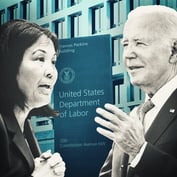Recent risk alerts issued by the Securities and Exchange Commission informed advisors that they must treat the decision to hire a turnkey asset management platform (TAMP) as an investment decision with fiduciary duties attached.
“The SEC is looking at: are you watching out for your client when you make this decision, or are you [mainly] using the TAMP because of some benefit you’re going to get? Advisors need to make sure they’ve made that decision based on the client’s best interest, not their best interest,” argues Scott MacKillop, CEO of First Ascent Asset Management, in an interview with ThinkAdvisor.
The risk alerts also covered wrap-fee programs, for which the commission requires processes and procedures in place for the purpose of “mak[ing] sure the decision to use the program was in the client’s best interest,” says MacKillop, a 2021 ThinkAdvisor LUMINARIES award winner in executive leadership.
Similar documentation is required regarding TAMP selection, and advisors are subject to penalties, including civil penalties and disgorgement of profits, if they do not comply, according to MacKillop.
His investment management firm was the first and arguably still the only full-service TAMP to use a flat-fee approach to pricing. When he launched his firm in 2015, that fee was $500.
He argues that many TAMPs who charge high fees and offer “mediocre” investment management avoid talking to prospects about the fiduciary aspect of TAMP selection, focusing their sales pitch instead on “the benefits to the advisor as opposed to the benefits to the client.”
Before forming First Ascent, he was a corporate and securities lawyer for more than 15 years.
ThinkAdvisor recently held a phone interview with MacKillop, who was speaking from First Ascent’s base in Denver. In the interview, MacKillop also discussed other pitfalls to avoid in selecting a TAMP and reasons for not hiring one at all.
Here are excerpts from our interview:
THINKADVISOR: What’s a hot issue in the TAMP world right now?
SCOTT MacKILLOP: The SEC recently sent a series of risk alerts to advisors and TAMPs. Most TAMPs don’t really talk about this at all.
Why not?
The alerts say that when [an advisor] select[s] a TAMP or a wrap-fee program, that’s a fiduciary decision — and you should know that [the SEC] look[s] at it that way.
What’s the SEC requiring advisors to provide?
Advisors need to have processes and procedures in place that describe how they’re going to view the TAMPs [for selection], what factors they’ll look at and how they’re going to make sure that the TAMP they select is in the client’s best interest.
If an advisor wants to work with a TAMP, they need to treat it like an investment decision to which their fiduciary duties are attached.
What do the alerts say about wrap-fee programs?
Advisors who use them need to have processes and procedures in place to ensure the decision to use the program was in the client’s best interest.
Why don’t TAMPs want to talk about these risk alerts?
Because it’s not necessarily in TAMPs’ interest to do that. A lot of TAMPs are charging pretty high fees, and the quality of their investment management is mediocre — sometimes maybe worse.
So they don’t want to talk about that. Instead, they want to talk about the great technology or practice management they’re going to provide.
They’re focusing their pitch on the benefits to the advisor as opposed to the benefits to the client.
The SEC is looking at: are you watching out for your client when you make this decision to use a TAMP, or are you [mainly] using the TAMP because of some benefit you’re going to get? That’s a big issue.
Are advisors vulnerable to a penalty?
That’s going to depend on the situation. If the SEC comes in and initiates an enforcement action against an advisory firm, that’s a pretty good penalty by itself.
But there could also be civil penalties, disgorgement of profits and all kinds of ancillary consequences.
The important thing is for advisors to treat the decision to hire a TAMP as an investment decision. It’s a very important perspective they need to have.
A lot of advisors don’t think about TAMPs that way. They think of them as service providers for getting financial planning software, for instance.
However, the decision to work with a TAMP is a fiduciary decision. So advisors need to make sure they’ve made that decision based on their clients’ best interest, not their best interest.
When an advisor decides to hire a TAMP, they have to make sure the price is reasonable and fair to the client, that their performance is good and that they manage assets in a reasonable way.
It’s the same set of questions that an advisor would need to go through if they were buying a mutual fund for their client’s account.
When you received those SEC risk alerts, what action did you take?
We created a set of processes and procedures for the advisors who work with us, which we sent to them so they could adopt them. We also sent a standard due diligence package.
If the SEC shows up in their office and asks them who the heck First Ascent is and why did you pick them, the advisor will have the processes and procedures in place and a very extensive due diligence file on why they selected us.
When I interviewed you in April 2018, your firm was the only TAMP operating with a flat-fee model. Have other TAMPS picked up on that?
When they were in head-to-head competition with us, some TAMPs quoted a flat fee to try to get the business.
But I haven’t seen another firm that provides a full-service TAMP offering that has adopted a flat-fee approach to pricing.









 July 05, 2022 at 12:06 PM
July 05, 2022 at 12:06 PM










